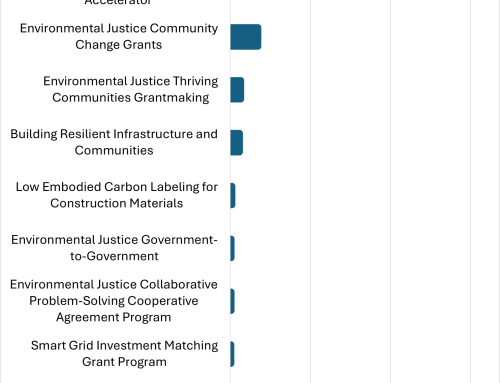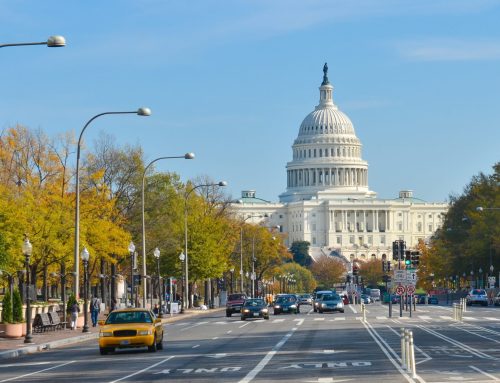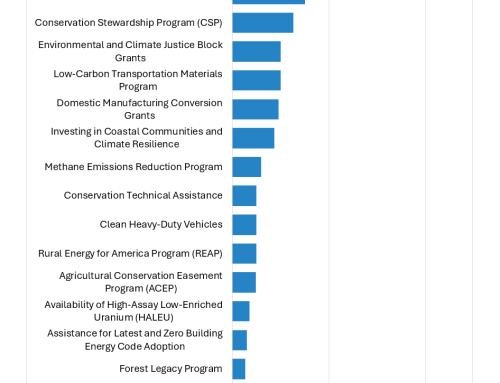
It has been well over a year since President Biden signed the Infrastructure Investment and Jobs Act into law. This month, we’re highlighting three types of activity from the Biden Administration – executive orders, new offices, and tools – to shape federal climate action.
Executive Orders
Before we get into the post-law executive orders, a few important executive orders are worth mentioning. On day one, President Biden signed E.O. 13990 Protecting Public Health and the Environment and Restoring Science To Tackle the Climate Crisis and E.O. 13985 Advancing Racial Equity and Support for Underserved Communities Through the Federal Government. Next, the E.O. 14008: Tackling the Climate Crisis at Home and Abroad. Though it predates the passage of the laws (it was signed on January 27, 2021), this executive order has been critical in shaping the Administration’s climate efforts including to lay out the Justice40 program and establish the Climate Policy Office, now headed by Ali Zaidi. Next, E.O. 14005, Ensuring the Future Is Made in All of America by All of America’s Workers, signed on January 25, 2021 directs the federal government to maximize the use of goods, products, and materials produced in the U.S. in order to help American businesses and workers thrive.
Lastly, it is expected that the Administration will release a new Executive Order to replace Executive Order 12898. E.O. 12898 was signed in 1994 by President Clinton to address the disproportionately high and adverse human health and environmental effects of federal programs and policies on minority and low-income populations. The new executive order was expected out in the summer of 2022, though is yet to be released.
Since IIJA was signed President Biden has issued a number of executive orders:
E.O. 14052: Implementation of the Infrastructure Investment and Jobs Act
The Infrastructure Investment and Jobs Act (IIJA) was signed into law on November 15, 2021. This executive order describes the goals of IIJA, implementation priorities for federal agencies, and establishes the Infrastructure Implementation Task Force (made up of Agency heads).
E.O. 14057: Catalyzing America’s Clean Energy Industries and Jobs through Federal Sustainability
On December 8, 2021, the President signed this executive order. The order directs “federal government to use its scale and procurement power” to achieve the following:
- 100 percent carbon pollution-free electricity (CFE) by 2030, at least half of which will be locally supplied clean energy to meet 24/7 demand;
- 100 percent zero-emission vehicle (ZEV) acquisitions by 2035, including 100 percent zero-emission light-duty vehicle acquisitions by 2027;
- Net-zero emissions from federal procurement no later than 2050, including a Buy Clean policy to promote use of construction materials with lower embodied emissions;
- A net-zero emissions building portfolio by 2045, including a 50 percent emissions reduction by 2032; and
- Net-zero emissions from overall federal operations by 2050, including a 65 percent emissions reduction by 2030.
President Biden also released a Federal Sustainability Plan in December 2021.
On September 16, 2022, President Biden signed this executive order to effectively implement the energy and infrastructure provisions of the Inflation Reduction Act (IRA) and “to accelerate United States global leadership in clean energy innovation, manufacturing, and deployment in a way that cuts consumer energy costs, creates well-paying union jobs and sustainable and equitable economic opportunity, advances environmental justice, and addresses the climate crisis”. This executive order describes the goals of the IRA, implementation priorities for federal agencies, establishes the White House Office on Clean Energy Innovation and Implementation to carry out the energy and infrastructure provisions of the Act, and expands interagency coordination efforts through the National Climate Task Force (see membership here).
On February 16, 2023, President Biden signed this executive order which, among other things, calls for agencies to submit an Equity Action Plan. The Annual Plan will include the “agency’s performance on the annual Environmental Justice Scorecard established pursuant to section 223 of Executive Order 14008, as applicable”.
New Offices
The Biden Administration and its Agencies have established a series of new offices to help implement programs. These include the Establishment of the Climate Change Support Office, which predated the passage of the Infrastructure Investment and Jobs Act. The Climate Change Support Office was established in May 2021 to “perform the specific project of supporting bilateral and multilateral engagement to advance the United States initiative to address the global climate crisis.”
Joint Office of Energy and Transportation
The Joint Office of Energy and Transportation (Joint Office) supports the deployment of zero-emission, convenient, accessible, and equitable transportation infrastructure, including with technical assistance. The Joint Office is led by Gabe Klein.
Office of Environmental Justice and External Civil Rights
The new office (formed out of a merger of existing offices) will have more than 200 EPA staff located across the nation who will work with state, tribal, and local government, and communities to address their environmental justice (EJ) concerns, provide grants and technical assistance, work with other EPA offices to incorporate EJ into their policies and programs, and ensure compliance with civil rights law. The office, announced in September 2022, will oversee a $3 billion climate and environmental justice block grant. It appears that there is still no Senate confirmed director at this stage.
Office of Climate Change and Health Equity
Per a directive in Executive Order 14008, this office was established on August 31, 2021, to address “the impact of climate change on the health of the American people.” The office sits in the Department of Health. The Center for American Progress released analysis in January 2023 on how the office can help mitigate the worst climate impacts.
The Grid Deployment Office at the DOE “works to improve electricity delivery and reliability and modernize and upgrade the electrical grid and critical electricity-generating facilities.” The office will invest $17 billion in programs that help address the nation’s transmission, distribution, and clean generation needs. The office is led by Maria Duaime Robinson.
Office of State and Community Energy Programs
At the DOE, the Office of State and Community Energy Programs will accelerate the deployment of clean energy technologies and support economic and workforce development. The Office is led by Henry McKoy and was established in August 2022.
The purpose of this office, established in January 2023, in the Department of the Interior, is to implement IIJA’s $4.7 billion investment to plug orphaned oil and gas wells on Federal, State, Tribal and private lands. The Office will be led by Kimbra Davis.
Office of Clean Energy Demonstrations
The DOE established this office to oversee more than $20 billion to support clean energy technology demonstration projects in areas including clean hydrogen, carbon capture, grid-scale energy storage, small modular reactors, and more. The Office is led by David Crane.
Tools
Each of the following tools are tracked in the Resource Library, but given the centrality of a number of these tools to policymaking, it is worth doing a roundup of some of the most noteworthy tools released by federal agencies to assist in implementation.
Climate Mapping for Resilience and Adaptation
View real-time maps showing where climate-related hazards are occurring today and see how your exposure to five common climate-related hazards is projected to change over time. This tool was funded by the Department of the Interior (DOI) and National Oceanic and Atmospheric Administration (NOAA).
This tool is intended to allow users to explore and produce reports on census tracts that the U.S. Department of Energy (DOE) has categorized as disadvantaged communities. There are 36 “burden indicators.”
Transportation Disadvantaged Census Tracts
This tool can be used to map project areas to determine the level of disadvantage according to DOT’s Justice40 definition.
EV Charging Justice40 Map Tool
This tool, developed by the Argonne National Laboratory, can help EV charging planning efforts align with the Justice40 goal of 40 percent of the benefits of federal investments going to disadvantaged communities. The tool was released in March 2022.
Climate & Economic Justice Screening Tool – Version 1,0
This tool helps federal agencies identify disadvantaged communities that are underserved and overburdened by pollution. The version 1.0 tool was released in November 2022, an update from an earlier beta version that was released. The tool was developed by the Council on Environmental Quality (CEQ), in the White House and identifies disadvantage at a census tract level (generally 1,200 – 8,000 people).
Conclusion
We will continue tracking progress on the Portal. If you have any others to add, get in touch: info@climateprogramportal.org


